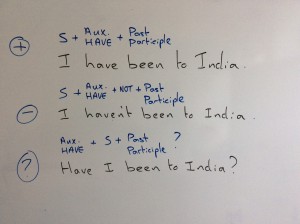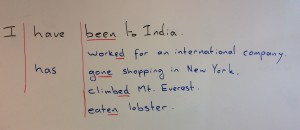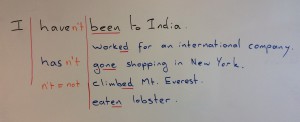Hello! This is Anthony Gaughan for Teacher Training Unplugged Radio. In this episode I’d like to talk about focusing on form in the language classroom, and how not to waste time on it. Let’s get started…
Quite often when people try to teach grammar, they make one or two things hard for themselves, and their students. One of these is thinking that in order adequately to analyze a grammatical structure, you need to label its component parts, particularly using jargon or technical terms.
This isn’t true.
Let’s assume that students need to know two basic things about any given new structure in order to start to use it: what it means and how it’s made (we could add how it sounds, but that’s a kind of subclass of how it’s made, so let’s leave that for now). Let’s further assume that what it means has already been clarified and understood.
The next job for a teacher is to help the students understand how to construct this structure, how to replicate it.

For many teachers, this begins with an example sentence on the board (e.g. I have been to India), which they then proceed to break into its component parts, labeling them as they go along: subject – auxiliary HAVE – past participle/3rd form verb.

The process is usually repeated for the three basic structural variations: positive utterance, negative utterance, interrogative utterance.
In a “student-centred” classroom, instead of the teacher simply declaring this information, the students may be involved in this process, with the teacher pointing at each item in the example in term, and asking “and this is (the)…?”, in the hope of eliciting these technical labels from the students.
This approach is frequently successful in eventually generating a formally accurate analysis of the target structure, but it tends to take a long time, be quite repetitive in terms of the information elicited, and crucially, it does not seem to contribute a great deal to students actually performing any better in subsequent controlled practice.
There may be many reasons for this, but for now I’d like to simply ask why it is that teachers, especially novice teachers or those on initial training courses, feel that this kind of thing is necessary at all.
Firstly, and most obviously, it is because a candidate’s ability to “clarify meaning, form and phonology to appropriate depth (criterion 2e in the Celta framework) is something they are expected to be able to do and must therefore demonstrate. But there is nothing in this criterion that demands a labeling of form, merely a “clarify(ing)” of it.
So if using jargon is unnecessary for assessment purposes and ineffectual in revealing useful patterns, what alternatives to it are there?
One is to think in terms of drop down menus, like a computer program menu bar. At each point along the utterance, imagine a drop down menu opening up wherever there is something that could be varied or exchanged for another example of the same type. So, taking our earlier example, and assuming the various personal pronouns are already strongly acquired, our attention would stop first at HAVE, and we would open up a drop-down below this to include HAS.

Thus we end up with S + HAVE/HAS
Then, when we move to the main verb, here in its past participle form, we open a drop down list and add 2-3 further examples (say climbed Mt. Everest/gone shopping in New York/eaten lobster/worked for an international company) By choosing 2 regular verbs and 2 irregular verbs, we present adequate data to suggest the underlying rule of form, which we can then check with simple questions, unless we haven’t already tacitly done so by eliciting the participle form from students by cuing with the base form, thus killing two birds with one stone.

Once the positive form has been unpacked in this way, the negative only requires those slots to be covered that are different. So in our example, we only have to establish a slot for the negation – all else remains equal so there is no point in ploughing the same furrow over and over again.

The same applies for the question form – once the inversion has been established, the work is essentially done.

In this way, an analysis of form should usually be a matter of diminishing detail, rather than increasing.
Once students have noticed the kind of thing that needs to go into any given slot, assuming they are clear about the overall meaning that the completed structure conveys, there is no need for them to know or to enunciate the technical label for it. Much like competent drivers have little to no idea what most of the technical markings on the roads are called, they are still able to respond to and interact with them perfectly safely and effectively.
(This is why road theory tests with questions asking for road features to be labelled are a total waste of time, and why it was grossly unfair that I failed my theory test first time on the basis of getting such a question wrong. But I digress…)
Apart from the relative economy and lack of need to be au fait with jargon, what other benefits are there to this approach? Well, as I see it, there are a couple:
1) instead of non-generative labels, students get more ready-to-use language
By providing 3-4 possible utterances, we are adding to students’ resources in a useful way. These utterances can be put to use in controlled practice or communicative practice later in the lesson, if well chosen, and thus serve at least a double purpose, of illustration and arsenal.
2) it emphasizes the concrete nature of language, not the abstract algorithms underneath
While I appreciate the elegance of a syntactic tree diagram as much as the next man, I’ve never found them especially useful for learning language, because they look so little like language doing its normal thing. A straightforward set of examples, with the key elements highlighted and presented so that the patterns stand out works much better for me, and I suspect for most people.
So if you are one of those teachers who, like me, sometimes feels like the focus on form stage in a lesson gets a bit too abstract for anyone’s good, then give this a try and see how it works for you. Any comments, queries, disagreements or death-threats, feel free to leave a comment below.
In the next episode, I’ll be talking a little about some of the challenges in understanding published materials, and how to overcome them.
Til next time, this is Anthony Gaughan, for Teacher Training Unplugged Radio, saying thanks for listening, and goodbye.
(Note: I will add whiteboard images to illustrate this shortly, so if anything isn’t clear from my description, check back later!)
hi Anthony
i enjoyed the post thx
in addition some corpus based tools can provide help in looking at more patterns associated with say have
e.g. http://nav4.stringnet.org/ret.php?query=have&button1=Search&radio_query_type=pattern&p_start_n=2&p_end_n=6&p_single_n=2&p_min_f=5&p_rank_name=rank5&p_page_size=30&c_collocate_pos=None&c_target_pos=None&c_order_by=mi&c_min_freq=20
we can see that (after been) got, had, done are common past participles; or that had + past participle is next common pattern after have + past participle.
the patterns or hybrid n-grams that stringnet uses combines both grammar and lexis which i think your post was also trying to get to?
ta
mura
Thanks for commenting, Mura. I wasn’t explicitly trying to point out the utility of typical examples and corpora as sources for these, so I’m grateful you drew out this area that I skated over. Also thanks for sharing Stringnet, which could be useful for a lot of other readers!
Hi Anthony,
I think this is a really good idea, if only because it reduces the number of words students need to learn too – how often do they really need to produce the words ‘past participle’ when they’re not labelling a language form?
The only thing I’d question is how you’ve marked the question form. While it’s true that it’s simple inversion, I find that I don’t take in arrows and/or they require extra layers of processing (i.e. you see the sentence, then the arrow, then process what the arrow signifies, rather than just seeing the correct version of the sentence) I try to encourage my students to avoid them in favour of writing out the correct version. What do you think?
Sandy
Hi Sandy, thanks for writing. When I made those board sketches I wondered if anyone would question that aspect of them, as I did myself. I opted for the arrow alternative more for the sake of visual economy here, and also to see how much simplification works for people. In general, I don’t go this far myself, and like you prefer to have separate breakdowns for each form (old habits die hard!)
[…] Jonny Ingham‘s Back to Basics series includes an introduction to timelines, including some beautiful examples which I’m very jealous of. Joanna Malefaki also has examples of timelines and CCQs. Marek Kiczkowiak offers tips for producing effective timelines. Gareth Rees shows some of the possible conventions of timelines (i.e. what the symbols mean). ELT Concourse has examples and asks you to guess what they show, then demonstrates how to build up a timeline with learners in the lesson. Anthony Gaughan demonstrates how to teach form without terminology. […]
Hi,
Some nice ideas here. I totally agree with the fact that concrete examples are more useful than just form. I saw a reported speech clarification yesterday where the trainee asked Upper Int students “So, if I say something in the present, what does it change to?” Students got lost. However, when presented with “The doctor said smoking kills…” they had no problems saying the verb won’t change in this example as smoking still kills! Just one question, however.
Do you think it is useful for teachers to “teach” students the labels in class? Trainees often ask me this and my stock answer is that when students want to look things up in a grammar book/online for themselves, it’ll be a lot easier when they know what it’s called. In addition, I often find it easier to offer correction when I can say things to students like, “Verb? Past participle?” But I guess I could just say, “went? grammar?”
Again, you are most thought-provoking!
Scott.
Thanks for stopping by and commenting, Scott. I think that generally, terminology should be the last thing to worry about. That is to say, it needs to be introduced, but only after the meaning and form of whatever it describes has already been established. I agree with you that once it has been established as a shared vocabulary, it can be used as a helpful shorthand. But as you neatly proved, even this isn’t really necessary much of the time! Thanks again.